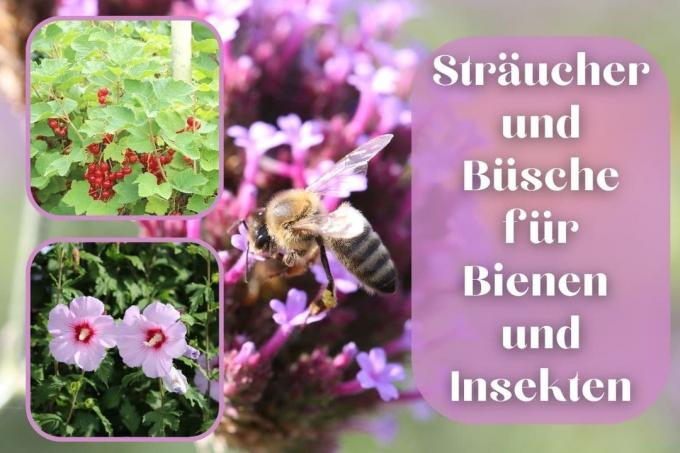
table of contents
- Insect-friendly early bloomers
- From B to F
- From G to R
- From S to Z
- Early summer and summer bloomers
- Late blooming bee bushes
- frequently asked Questions
Flowering bushes and shrubs attract many useful insects and birds into the garden and thus make an important contribution to nature conservation. The selection of insect-friendly trees is huge and varied. Here you will find 33 bee bushes.
In a nutshell
- bee-friendly shrubs and bushes are rich in nectar and pollen
- wide open and not densely filled calyxes ideal target for bees and insects
- A mixture of early, summer and late blooming is recommended
- thus increases the number of flowers and the supply of pollen
Insect-friendly early bloomers
From B to F
Farmer's Jasmine (Philadelphus coronarius)

- narrow upright, overhanging when old
- between 200 and 300 cm tall
- weakly serrated, deep green leaves
- Flowering period May-June
- bowl-shaped, creamy white, fragrant flower clusters
Tip: Cultivated forms of this traditional cottage garden wood are neither bee-friendly nor insect-friendly.
Barberry (Berberis)

- upright, dense growth, arching overhanging when old
- Growth height up to 300 cm
- thorny branches and leaves
- Flowering time from May to June
- Bee bushes with small, pure yellow flowers
- black, blue-ripened fruits after flowering
- Moderate nectar, little pollen
Medlar (Mespilus germanica)

- bizarre growth, 300 to 800 cm high
- crooked trunk, broad crown
- blooms from May to June
- small white or pink flowers
- small edible, pear-shaped fruits
- rich supply of nectar and pollen
Gorse 'Lena' (Cytisus scoparius)

- broom-like, upright growth, up to 150 cm high
- densely branched, stocky
- grape-shaped butterfly flowers from May to July
- in yellow, orange and red tones
- Low nectar, moderate pollen supply
Buckthorn (Rhamnus frangula)
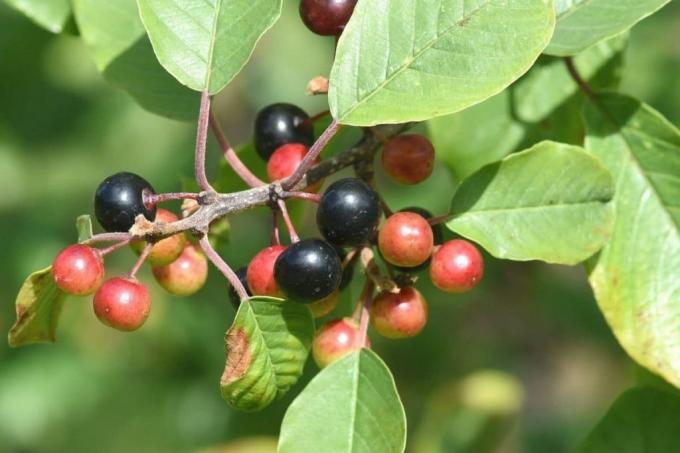
- fast growing, multi-stemmed
- from 200 to 400 cm tall
- blooms from May to July
- Flowers small, yellowish, inconspicuous
- rich supply of nectar, moderate pollen
- red to black fruits, poisonous
Firethorn (Pyracantha coccinea)

- thorny, upright, bushy wood
- becomes 100 to 300 cm high
- May to June white panicles with lots of pollen
- moderate supply of nectar and pollen
- yellow, orange or red fruits after flowering
- inedible for humans
Tip: This shrub is also used as a nesting place for birds and its berries as a source of food.
lilac (Syringa vulgaris)

- upright, densely branched
- becomes 400 to 600 cm high
- Forming scrub and runners
- Flowering period May to June
- purple to purple panicles, strongly fragrant
- Moderate nectar, rich supply of pollen
From G to R
Laburnum (Laburnum anagyroides)
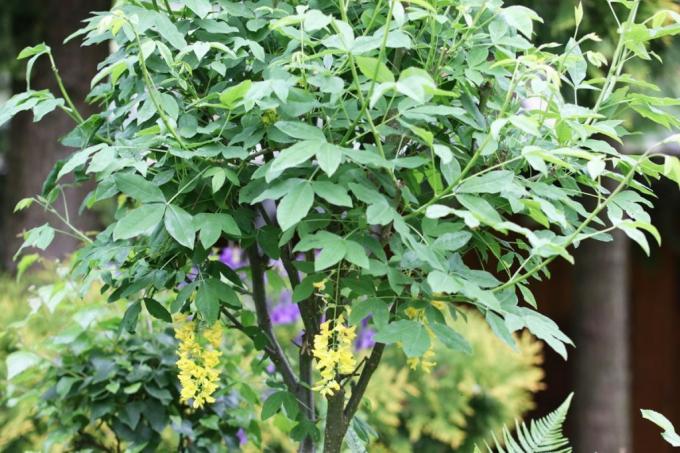
- narrow, funnel-shaped large shrub
- Growth height 200 to 800 cm
- May / June yellow, pendent flower clusters
- a lot of pollen, little nectar
- all parts of the plant poisonous
Domestic berry bushes

- mostly very good nectar and pollen supply
- different flowering and fruiting times
- Raspberry particularly bee-friendly
- highest pollen and nectar value among berry bushes
- also because of the long flowering period from May to August
Tip: Other nectar willows worth mentioning include currants, blackberries and gooseberries.
Domestic wild roses

- Heights of growth from 100 to 400 cm
- different colors, mostly edible fruits
- usually only bloom for a few weeks a year
- different colors and rose hips in autumn
- safe and popular nesting sites
- Moderate nectar and pollen supply
Tip: Suitable wild roses are, for example, the dog rose, vinegar rose, cinnamon rose and beaver rose as well as the red leaf rose and wine rose.
Cornelian cherry (Cornus mas)

- often multi-stemmed with emerging branches
- tree-like when old, 300 to 500 cm high
- Flowers from early March to late April
- simple, golden yellow, umbel-shaped
- Plentiful nectar, moderate pollen
- red drupes in autumn
Copper rock pear (Amelanchier lamarckii)

- multi-stemmed shrub, overhanging branches
- Height between 100 and 300 cm
- Leaves shoot copper-colored, later green, in autumn orange-red
- white flower clusters in April
- dark purple, edible berries in autumn
- Bee bushes with little pollen and a moderate supply of nectar
Mayflower bush (Deutzia gracilis)
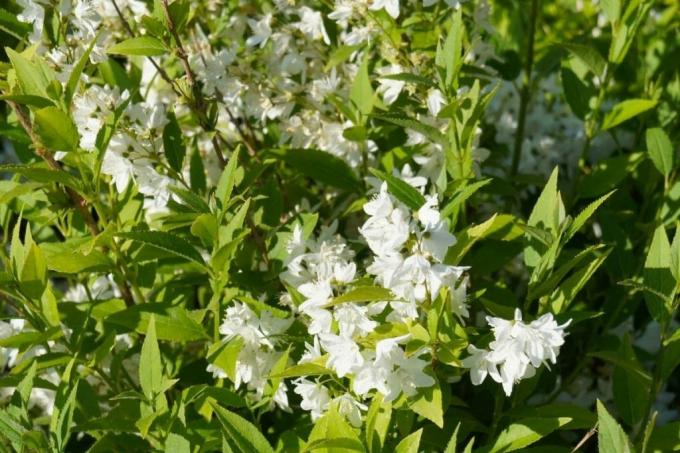
- upright, densely bushy growth, 60-80 cm high
- profuse flowering from May to June
- white, panicle-shaped star-shaped flowers
- just nectar no pollen
- flowers on perennial wood
Red dogwood (Cornus sanguinea)

- upright, later broad growth, forming runners
- Growth height 300 to 500 cm
- Flowering time May / June
- white flowers, lots of nectar and pollen
- August / September black berries
- inedible for humans
Red honeysuckle (Lonicera xylosteum)

- broadly upright, well branched
- slight zigzag shape of the shoots
- up to 300 cm high and wide
- yellowish-white flowers from May to June
- lots of nectar and pollen
From S to Z
Sal willow (Salix caprea)
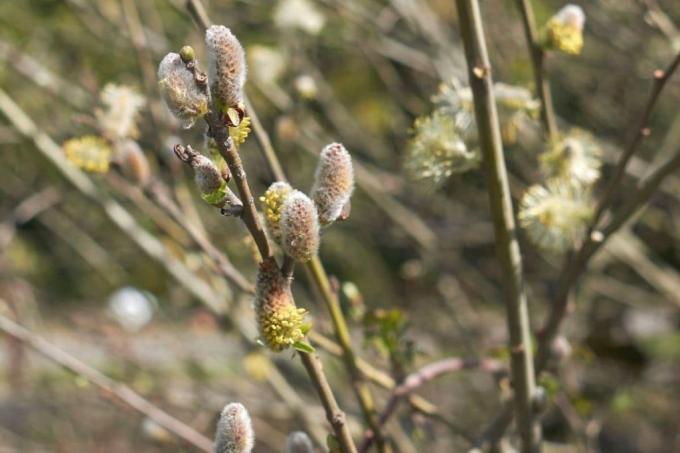
- up to 1000 cm high shrub or small tree
- either male flowers packed with pollen
- or nectar-rich female flowers
- flowers from March to April
- silvery-yellow pussy willow
- excellent nectar and pollen value
Tip: Due to their importance as a source of food for insects, from 1 March to 30th September no branches are cut.
Sloe (Prunus spinosa)
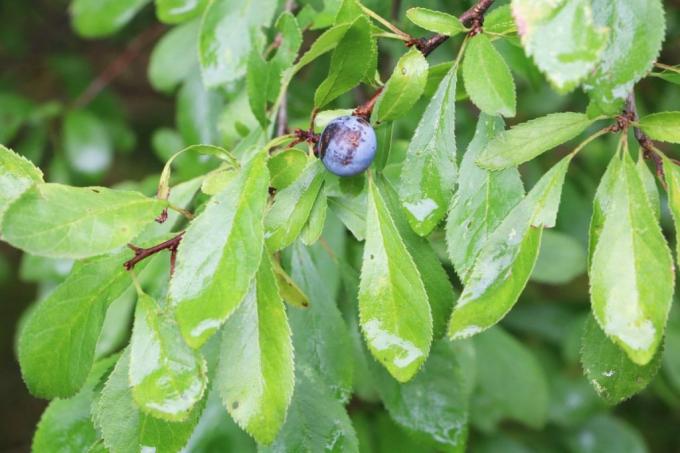
- bushy, spreading, multi-stemmed shrub
- Branches and shoots thorn
- from 100-300 cm high
- flowers from March to April
- fragrant, white flowers on the shoots
- bluish-black fruits from August
- Moderate nectar, abundant pollen
Snow heather (Erica carnea)

- Bee bushes up to 30 cm high
- important source of food after hibernation
- blooms from January to April
- pink or reddish flowers
- moderate supply of pollen
- rich nectar offer
Rowan / Mountain Ash (Sorbus aucuparia)

- often multi-stemmed up to 1200 cm high
- pinnate foliage, yellow to orange in autumn
- blooms from May-June
- panicle-shaped white flowers
- from August red fruit decorations
- Moderate nectar and pollen
Bird cherry (Prunus avium)
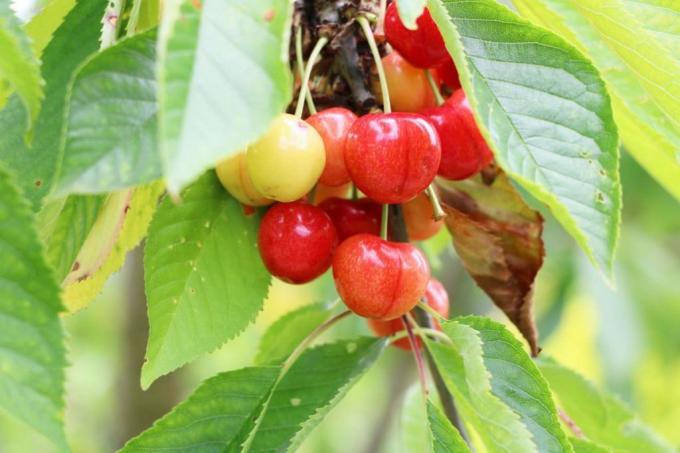
- often multi-stemmed, loose structure
- between 200 and 2500 cm high
- blooms from April-May
- small white flowers, noticeably many stamens
- very bee-friendly, rich supply of nectar and pollen
Tip: The nectar of bird cherry also attracts ants. This in turn keeps the plant free from vermin.
Ornamental currant (Ribes sanguineum)
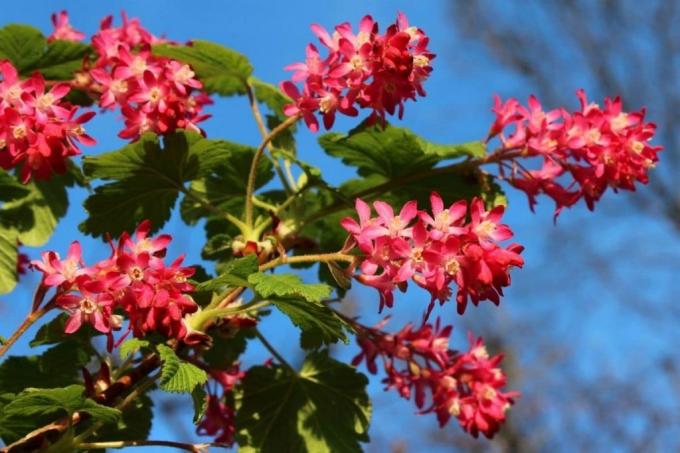
- upright, heavily branched
- up to 300 cm high
- Leaves and flowers almost simultaneously
- flowers from March to April
- deep dark pink to red flower clusters
- in summer dark purple berries with blue frosting
- lots of nectar and pollen
Two-pronged hawthorn (Crataegus laevigata)

- irregular, multi-stemmed beehives
- between 200 and 1000 cm high
- white flowers from May to June
- Bee pasture with lots of nectar and pollen
- edible scarlet fruits in autumn
Medlars (Cotoneaster)

- evergreen ground cover
- 15 to 50 cm high, depending on the variety
- in spring white to pink flowers
- rich nectar offer
- orange-red or black berry decorations in late summer
- all parts of the plant poisonous
Early summer and summer bloomers
St. John's wort (Hypericum androsaemum)

- bare shrub, creeping to upright trunk
- approx. 30 to 80 cm high
- yellow, cupped flowers from June-August
- fleshy, spherical to spindle-shaped berries in autumn
- initially red-brown, later black
- excellent bee pasture, lots of pollen
liguster (Ligustrum vulgare)

- broadly upright, expansive
- up to 500 cm high
- Growth stagnates with age
- in June / July white flowers with a strong scent
- Bee bushes with plenty of pollen and nectar
Panicle hydrangeas (Hydrangea paniculata 'Levana')
- broad, upright, fast-growing shrub or bush
- up to 300 cm high
- blooms from July-October
- huge, pure white inflorescences
- very good nectar and pollen dispenser
Snowberry (Symphoricarpos albus)
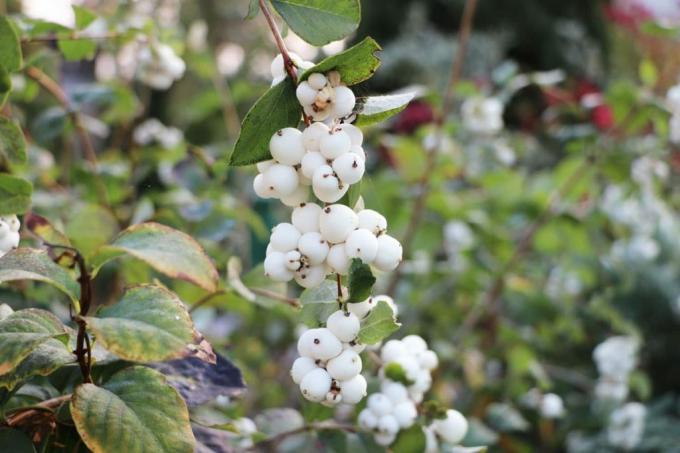
- dense, upright bushy, overhanging
- about 100 to 200 cm high
- blooms from June to October
- bell-shaped, white to pink flower clusters
- snow-white, poisonous berries
- low supply of nectar and pollen
Shrub cinquefoil (Potentilla fruticosa)

- upright bushes 20 to 100 cm high
- Bark is peeling off in long shreds
- blooms from June to September
- bright yellow flowers
- moderate nectar and pollen value
Thousand flower bush (Tetradium daniellii)

- multi-stemmed, initially shrubby, later as a tree
- Height from 1000 to 1500 cm
- flowers from July to August, pleasant scent of flowers
- large, greenish-white panicles of umbrella
- very good source of nectar for late summer
Late blooming bee bushes
Clandon's beard flower (Caryopteris x clandonensis)
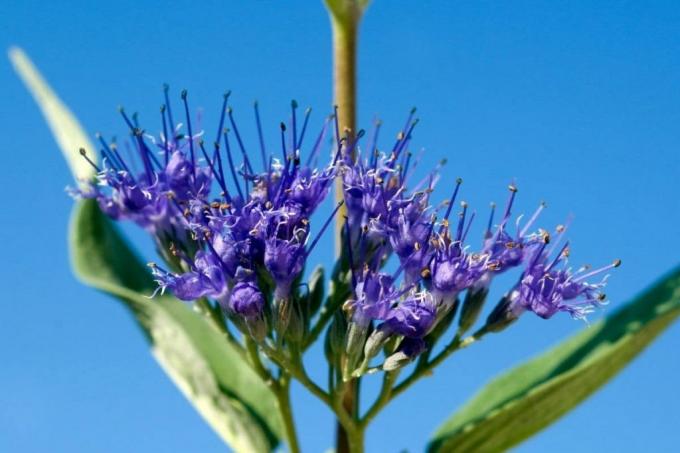
- up to 100 cm high subshrub
- naturalized neophyte
- Flowering time in August / September
- blue umbels, very aromatic fragrance
- Very good nectar and pollen values
Shrub ivy 'Arborescens' (Hedera helix)

- small shrub, does not climb
- Heights of about 150 cm
- blooms from September to October
- yellow-green, umbel-shaped flowers
- particularly insect-friendly, important nectar supplier
Shrub Marshmallow (Hibiscus syriacus)

- upright shrub, 100 to 400 cm tall
- not to be confused with the common marshmallow (Althaea officinalis)
- blooms from July-August
- Flowers blue-violet, white in the middle with red spots
- little nectar, a lot of pollen
Winter snowball (Virburnum bodnantense)

- initially stiffly upright, densely branched
- later densely bushy, overhanging branches
- Runners-forming bushes
- Flowering period from November to April
- white-pink, fragrant clusters of flowers
- little pollen but plenty of nectar
frequently asked Questions
These plants offer these animals nesting places and food in the form of nectar or pollen. One speaks of a bee pasture when a particularly large number of bee-friendly plants grow on an area.
About 80 percent of our native plants are dependent on cross-pollination by insects. Only through them can fruits develop. Without them there would be neither strawberries nor apples, pears or cherries. Honey bees do the largest share of pollination.
No, not every flowering plant is valuable to bees and other insects. Wild bees, for example, only feed on native plants. They are not interested in those modified by breeding, their flowers are sterile, they produce neither nectar nor pollen. Plants with double flowers are also not insect-friendly. Insects have no access here, so that neither seeds nor pollen can develop. An example of this is forsythia.


